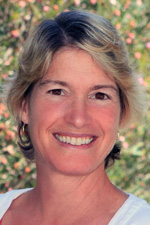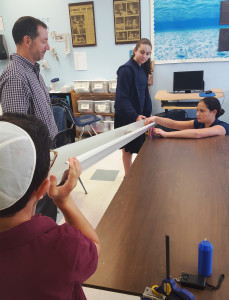By Eva Trieger


SAN DIEGO — Downloading new software intimidates me, learning my new OS baffles me, and just about any gadget that vaporizes to the Cloud sends me running for cover. But as much as I try to maintain my Neanderthal status, technology won’t allow me to be a backward ostrich much longer. Thankfully, schools like Soille San Diego Hebrew Day are forging ahead to meet the future….today!
The Center for Initiatives in Jewish Education created an engineering and design program entitled STEM. The Science, Technology, Engineering and Mathematics program is not a new concept for Soille, a pre-school -8th grade school that currently and proudly holds the greatest number of Science Fair winners in the county. However, this past summer, Soille Hebrew Day School earned a grant that allowed them to put even greater emphasis on equipping today’s students for tomorrow’s world.
The mission statement from the California Department of Education is as follows:
“K-12 STEM education encompasses the processes of critical thinking, analysis, and collaboration in which students integrate the processes and concepts in real world contexts of science, technology, engineering, and mathematics, fostering the development of STEM skills and competencies for college, career, and life. “
Two weeks ago, I had the great fortune to meet with Soille’s STEM implementers: Matt Bessler, Rabbi Meir Cohen, and Headmaster Rabbi Simcha Weiser. They informed me that Soille Hebrew Day has always embraced the County science fairs because they are deeply committed to the Jewish concepts of exploration and understanding. As the trio explained to me, Jews have a natural curiosity to dissect and find meaning in their world, not just as hands-off observers. To this end, the Science curriculum enhances the Jewish learning and the two counterparts create a whole student, one who is ready to tackle the real world.
Dr. Adrian Krag is mentoring Soille’s West Coast CIJE STEM program and was very proud to bring the pilot program to the middle schoolers. It is the first school on the West coast to upgrade its technology, employ smartboards, and institute unique programs to teach students and staff the importance and applicability of these tools for problem solving in everyday situations. The decade-long relationship with CIJE has reinforced the faculty’s comfort with, and commitment to, bringing it to fruition.
Many parents and all teachers have heard the “When I am every going to use this in real life?” from a querulous student facing a challenging Math or Science concept. That’s what STEM is about. This invitation for innovative engineering and problem-solving through critical thinking encourages and draws out even the most reluctant learner, to discover for him/herself why something works the way it works…or how it can be made to work better.
Currently, the middle schoolers are working on a Bobsled lab. This teaches them about forces, motion, and friction. How does one calculate force? What is a trajectory and how can I graph it? These ideas are all taught, or perhaps I should say, experienced, with a very hands-on approach, bringing it directly into the student’s cognition without relying solely on the printed word of some scientist of old. These students literally get to reinvent the wheel!
How does this creative approach mirror or support the holistic Jewish education that Soille students have been receiving since 1963? In response to my question, Rabbi Meir Cohen said that the children learn it on their own, “not knowledge, but insight.”
The novel program is not without its challenges. Firstly, the science lab doesn’t look like a standard lab with sinks, Bunsen burners, or graduated cylinders. It is flexible and everything is on wheels. This is a bit puzzling to the older generation who have visions of their own Science labs in middle and high school. Apparently, it caused quite a stir on Back to School Night.
Not all parents were put off. In fact, the number of parents who are engineers and technologically oriented have come in and shared their wisdom and expertise with the 6-8th graders. They are well received and offer much to the credibility and impetus of the program. In addition, there has been some communication with the local universities. Bessler and the rabbis reported that outside voices offer new perspectives.
Differentiation is made possible because all modalities are tapped into as students explore the labs and teaching. The teacher presents the lesson as “Here’s the goal, and there are many different ways to get there. “ This allows for all types of learners to be successful and benefit from the exercise and activities in a meaningful and personal way. Students are encouraged to delve into their creativity, using animation, voices, songs etc. This goes way beyond the Power Point that has become the mainstay of so many classrooms in the past decade. The program also is forward thinking in that it prepares students for the work place of the 21st century.
No longer are we a society of office drones sitting in cubicles, meeting only at the water cooler. Today, teams work together in collaboration, employing technology. It is process driven by and requiring innovation, networking and a free exchange of intellectual ideas. And this is perhaps where the Jewish way of understanding comes in.
The Gruss Life Moments Funds was established in 1991 with the sole purpose of supporting Jewish education. Founder, Joseph Gruss, grew up in Lvov, Poland. His father was a Talmudic scholar, and though Joseph went on to become a banker, he was committed to Jewish Education. He saw a need to improve Jewish schools in the United States and he, along with his Czechoslovakian wife, established this amazing legacy. Their efforts are intimately entwined with the CIJE, and their largesse has created a path for understanding the world far beyond that which Mr. and Mrs. Gruss could have imagined.
Rabbi Weiser spoke of the greatest engineer of all: G-d! Weiser said the He engineered the world and provided us a guide for living with the Torah, but that Judaism doesn’t stop there. It is not theoretical nor simply historic, but that we are charged with using our wits to understand our world and make it better. The onus is on us to take it apart and put it back together to make things function more smoothly and harmoniously. So while some may feel that technology is disconnecting us from the world, used constructively, it will actually deepen our understanding of the world around us, and our relationships with each other.
Dr. Krag has been an inspiration to the STEM program at Soille Hebrew Day, encouraging students to “figure it out on your own,” “practice with a team,” and reassuring them, “failing just provides a new opportunity to try it a different way.” Teacher, Matt Bessler explained, “We give problems, we don’t teach. We’ve given up on the scripted things, to make room for the unscripted.”
On a personal note, I’m quite excited about the end-of-year project. Students are to make their own Rube Goldberg invention using a specific number of levers, pulleys, screws, and inclined planes. I’m certain the innovations will prove entertaining, artistic, educational and challenging. And it does console me to know that if by June, I’m still unable to move pictures from my phone to my laptop, or how to burn a CD, there’ll be a bumper crop of Soille Hebrew Day students that can teach me how to embrace my inner engineer.
*
Preceding republished with permission from L’Chaim San Diego, a monthly magazine of Jewish interest.
Trieger may be contacted via eva.trieger@sdjewishworld.com